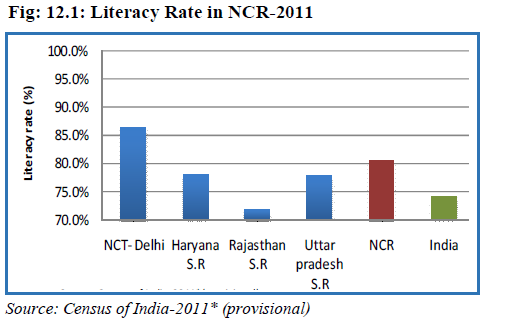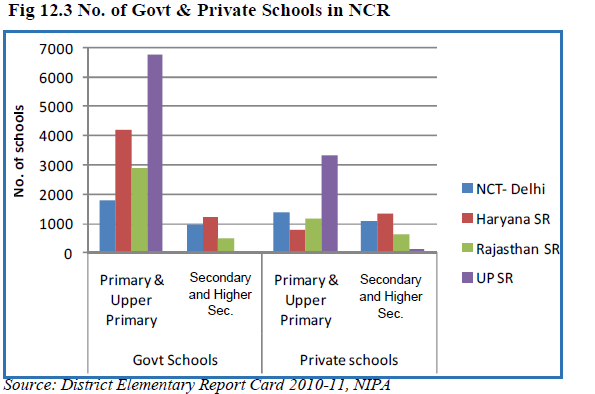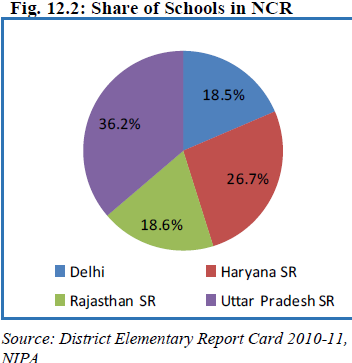National Capital Region (India): Education
This article has been sourced from an authoritative, official readers who wish to update or add further details can do so on a ‘Part II’ of this article. |
The source of this article
Draft Revised Regional Plan 2021: National Capital Region
July, 2013
National Capital Region Planning Board, Ministry of Urban Development, Govt. of India, Core-4B, First Floor, India Habitat Centre, Lodhi Road, New Delhi-110003
National Capital Region Planning Board
National Capital Region (India) : Education
BACKGROUND
The Regional Plan-2021 for the National Capital Region (NCR) specifically recognised the growthstimulating and sustaining role of social infrastructure including education and health infrastructure in the regional development process. While physical infrastructure improves physical connectivity, the sustainability of economic growth and development is dependent on social infrastructure, more importantly education and health infrastructure. Since NCT-Delhi has traditionally been a city with relatively better availability of educational infrastructure than rest of the NCR, 2.7% migration into Delhi (census 2001) has been observed on account of education. This sector therefore requires immediate steps to make NCR, outside NCT-Delhi, attractive for people in different regions/districts of the NCR. Such balancing is essential for even growth of the NCR. In NCR, CBSE and State Education Boards uniformly follow the "10+2+3" pattern of education. In this pattern, 10 years of primary (also referred to as Elementary education) and secondary education is followed by 2 years of higher secondary (usually in schools having the higher secondary facility, or in colleges), and then 3 years of college education for bachelor's degree. Ten years are further divided into 5 years of primary education and 3 years of upper primary, followed by 2 years of high school.
12.2 EXISTING SCENARIO
12.2.1 Existing situation of Educational Infrastructure in NCR
Literacy Rate- According to the Census 2011, the literacy rate in the NCR (80.4 percent) is higher than that of all India average of 74.0 percent. When compared among the Sub-regions, NCT-Delhi (86.3 percent) has the highest literacy rate followed by Haryana (78.2 percent), Uttar Pradesh (77.7 percent) and Rajasthan (71.7 percent) Sub-Regions (Fig 12.1).
12.2.2 Education facilities: There are 28,284 schools in NCR out of which, 18,386 (65.0%) are Government schools and 9898 (35.0%) are private schools. Out of the 18386 government schools in NCR, 15659 are primary and upper primary schools, where as only 2727 schools are Secondary and Higher Secondary schools. The private sector has set up more secondary and higher secondary schools in NCR as compared to government agencies. Of the total 9898 private schools in NCR, 6689 are primary and upper primary school whereas 3209 schools are Higher Secondary schools.
The number of schools located in a particular area is the parameter for determining educational access. In the NCR, Uttar Pradesh Sub Region (10249 schools) has the highest number of schools, followed by the Haryana Sub Region (7541 schools), Rajasthan Sub Region (5255 schools) and then Delhi (5239 schools) (Fig 12.2 and Table 12.1).
In 2011, the population served by one school is the highest in Delhi (3198), followed by Haryana sub-region (1464) and Uttar Pradesh Sub-region (1423). The least population served per school’ ratio is in Rajasthan sub-region (699). Some of the Districts like Faridabad (2726), Gurgaon (1890), Panipat (1988) in Haryana sub-region and Ghaziabad (2155), GB Nagar (1518) in Uttar Pradesh sub-region have the highest population served per school’ in NCR. Districts like Rewari (921) and Alwar (699) have the least population served per school’ ratio. High ratio of one school per person may be attributed to the high density of population and large concentration of urban population in a compact area (Table 12.2).
Out of the total 5239 schools in NCT Delhi, 2772 schools (52.9%) are government schools and 2467 schools (47.1%) are private schools. There are 3201 primary and upper primary schools and 2038 secondary and higher secondary schools in Delhi (Fig 12.3).
In Haryana sub-region, out of the total 7541 schools, 5400 schools (71.6 %) are government schools and 2141 schools (28.4%) are private schools. There are 4980 primary and upper primary schools and 2561 secondary and higher secondary schools in Haryana sub-region.
In Rajasthan sub-region, out of the total 5255 schools, 3416 schools (65.0%) are government schools and 18391 schools (35.0%) are private schools. There are 4088 primary and upper primary schools and 1167 secondary and higher secondary schools in Rajasthan sub-region. In Uttar Pradesh sub-region, out of the total 10,249 schools in 6798 schools (66.3 %) are government schools and 3451 schools (33.7 %) are private schools. There are 10,079 primary and upper primary schools and 170 secondary and higher secondary schools in Uttar Pradesh Sub-Region.
12.2.3 Enrollments in Primary and Secondary Schools
Elementary education is the foundation of the pyramid of education system, stemming from provisions enshrined in the Directive Principles of State Policy and the 86th Amendment in the Constitution of India. The Sarva Shiksha Abhiyan (SSA), a flagship programme for Universalization of Elementary Education, has created awareness regarding the importance of elementary education. It envisages Universal Access and Enrollment to the formal Primary and Upper Primary Education system. Figure 12.4 shows the number of enrollments in the Primary and the Upper Primary Schools of the Sub Regions of the NCR from 2004 to 2011. It has been observed that the number of enrollments in the Primary level is comparatively higher than that in the Upper Primary Schools. At Sub Regional level it has been observed that the number of enrollments has increased tremendously in both the Primary and the Upper Primary Schools of the NCT of Delhi in the same period. At district level it has been observed that Gross Enrollment Rates (GER) have drastically reduced during 2009 to 2011 in the districts of Faridabad (16.4) and Jhajjar (74.6) of the Haryana Sub Region and Central and North Delhi of NCTDelhi. The other constituent districts of the NCR have either registered a constant or an increasing GER. There has been a decline in the overall Gross Enrolment Rates (Table 12.3).





